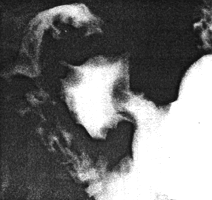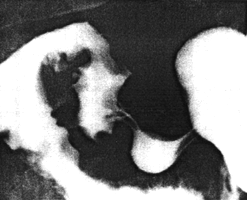



Go to chapter: 1 | 2 | 3 | 4 | 5 | 6 | 7 | 8 | 9 | 10 | 11 | 12 | 13 | 14 | 15 | 16 | 17 | 18 | 19 | 20 | 21 | 22 | 23 | 24 | 25 | 26 | 27 | 28 | 29 | 30 | 31 | 32 | 33 | 34 | 35 | 36 | 37 | 38 | 39
Chapter 30 (page 150)
Case 30.2. W.C., 33 year old male, a known case of duodenal ulceration, presented
with epigastric pain and malaena. Radiographic examination showed no abnormality in
the oesophagus and stomach. The duodenal bulb was deformed and contained an ulcer
niche (not clearly visible in illustration) (Fig.30.2A). Cyclical contractions
of the pyloric sphincteric cylinder occurred at a rate of 3 to 4 per minute; the range of
individual contractions appeared to be normal, varying from full expansion (Fig.
30.2A) to maximal or near maximal contraction (Fig. 30.2B). A
month after the examination the duodenal ulcer perforated, necessitating laparotomy and
omental plugging of the perforation; the stomach was normal at operation.
A | B |
| Fig. 30.2 A,B. Case W.C. A Pyloric sphincteric cylinder distended.
Deformed duodenal bulb due to active ulceration. B Normal contraction of sphincteric
cylinder. Duodenal bulb deformed
|
In 73 of 77 cases of duodenal ulceration, cyclical contractions of the pyloric sphincteric
cylinder were found to be normal in character, range and frequency. (It has to be
reiterated that these features were determined while using a fluid barium suspension).
Normal contractions were seen irrespective of the size of the ulcer, its exact position
(whether located in the apex, centre of base of the duodenal bulb) and irrespective of the
degree of deformity and/or narrowing of the bulb (in 9 of the cases there was appreciable
narrowing).
In 2 of 60 cases in the first group in whom normal contractions of the cylinder were
absent, the stomach was aperistaltic, hypotonic and moderately dilated, with delayed
emptying in the erect position; this was not due to duodenal narrowing or obstruction,
the cause of the aperistalsis being undetermined. In 2 of 17 cases in the second group
with absent cyclical activity, atypical contraction of the cylinder was noted.
It has been stated that the acid-secretory characteristics of duodenal and pyloric ulcers are
similar (Chap. 29). The present findings show that there are important differences in the
motility patterns of the pyloric sphincteric cylinder in the two conditions. Normal
contractions usually occur in duodenal ulceration while severe motility disturbances are
present in pyloric ulceration (Chap. 29). The findings confirm those of Liebermann-
Meffert and Allgöwer (l98l), who stated that motor disorders of the gastric
musculature were less evident in duodenal than gastric ulceration and were, in fact, of
minor importance in duodenal ulceration.
"Antral" gastritis may occur in cases of duodenal ulcer, but is usually of a mild, diffuse
type; gastric ulceration is associated with much more severe inflammatory alterations,
according to Schrager et al. (l967). Liebermann-Meffert and Allgöwer (l98l) found
that abnormal features of the muscular layers and ganglion cells were less severe in
duodenal than in gastric ulcer. Earlam et al. (l985) described a high incidence of chronic
superficial and chronic atrophic antral gastritis in a selected group of duodenal ulcer
patients, all requiring operation after prolonged but unsuccessful medical therapy.
Brooks (l985) looked upon gastritis of the antral mucosa as a common finding in
duodenal ulceration. Hui et al. (l986) found active, chronic gastritis in almost all patients
with duodenal ulcer; in the majority it was of moderate severity.
The less severe grades of pyloric gastritis occurring in association with duodenal ulcer (as
opposed to the more severe gastritis in pyloric and other gastric ulcers) probably accounts
for the normal motility of the pyloric sphincteric cylinder in the former.
Previous Page | Table of Contents | Next Page
© Copyright PLiG 1998








